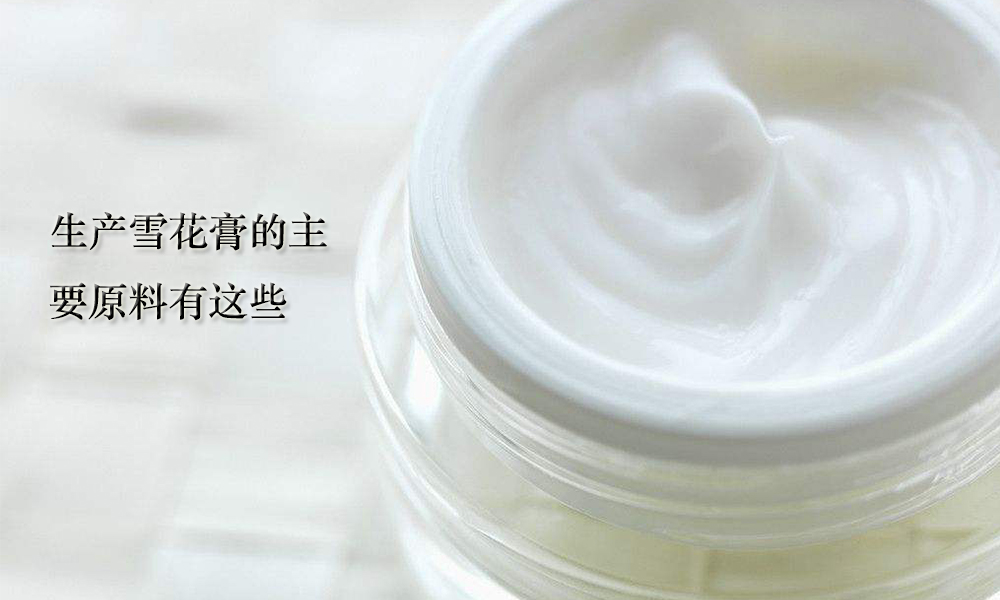
Snow cream is a cream with stearic acid as the main ingredient. Because when applied to the skin, it melts into the skin like snowflakes and disappears, so it is called snowflake cream. Snowflake cream forms a thin film on the surface of the skin to isolate the skin from the dry air outside. It can control the evaporation of epidermal moisture and protect the skin from dryness, cracking or roughness.
The main raw materials for producing cream are stearic acid, alkali, water and essence. However, in order to have a good moisturizing effect, glycerin, sorbitol, propylene glycol and polyethylene glycol are often added. Let’s take you through the main raw materials of cream:
1·Stearic acid:
Also known as stearic acid, stearic acid, and fatty wax, it is a fatty acid widely present in nature. It is found in almost all oils and fats in varying amounts. The content of stearic acid in animal fats is relatively high, such as butter, which can reach 24%, and vegetable oils, which contain 0.8% camellia oil and 6% palm oil, but the content in cocoa butter is less. Up to 34%. It is an indispensable raw material for dairy cosmetics and is commonly found in creams and lotions. It emulsifies the cream, turning it into a stable and white paste.
2. Glyceryl monostearate:
The full name of monoglyceride It is a mono-fatty acid glyceride (or glycerol mono-fatty acid ester), which has two configurations, namely 1-MG and 2-MG. According to the names of the main fatty acids, monoglycerides can be divided into glyceryl monostearate, glyceryl monosilicate, glyceryl monooleate, etc. Among them, glyceryl monostearate is the one with the largest output and the most application. Monoglycerides are generally oily, greasy or waxy, with light yellow or ivory color, greasy smell or tasteless, which is related to the size and saturation of the fat group, and has excellent sensory properties. Monoglycerides are insoluble in water and glycerol, but can form stable hydrated dispersions in water. In addition, monoglyceride is a polyol-type nonionic surfactant. Because its structure has a lipophilic long-chain alkyl group and two hydrophilic hydroxyl groups, it has good surface activity and can emulsify, It has functions such as foaming, dispersing, defoaming, and anti-starch aging. It is the most widely used emulsifier in food and cosmetics. Make the paste fine and smooth in the snow cream.
3. White oil:
White oil, also known as paraffin oil and white oil ,mineral oil. Colorless translucent oily liquid, no or almost no fluorescence, odorless and tasteless when cold, slightly petroleum-like smell when heated, insoluble in water, ethanol, soluble in volatile oils, miscible in most non-volatile oils, sensitive to light, It is stable to heat and acid, but will slowly oxidize when exposed to light and heat for a long time. Commonly used ones include industrial grade white oil, cosmetic grade white oil, medical grade white oil, food grade white oil, etc. Different types of white oil also have different uses. Plays a solidifying role in the cream.
4. Cetyl alcohol (cetadecanol):
Cetyl alcohol :
White crystals with a rose aroma. Soluble in ethanol, ether, benzene, chloroform, acetone, insoluble in water. It is suitable for use in various cosmetics as a base, especially suitable for creams and lotions; in medicine, it can be directly used in W/O emulsifier pastes, ointment bases, etc. The raw materials of Pingpingjia can also be used as defoaming agents, soil and water moisturizers, gas chromatography fixatives (color-forming agents); they can also be used as raw materials for the production of alcohols, amides and sulfonated products for detergents; and as heat preservation agents for rice fields.
Stearyl alcohol:
White flakes or granules. Soluble in alcohol, benzene and chloroform, insoluble in water. It is widely used in daily chemicals, textiles, printing and dyeing and other industries, and is a raw material for manufacturing surfactants, emulsifiers and various additives. Used as a base (emulsifier) for creams and lotions in cosmetics. Stearyl alcohol has stronger emulsion thickening properties than cetyl alcohol.
These two are used as moisturizers in the cream to moisturize.
5·KOH/NaOH:
Potassium hydroxide/sodium hydroxide in Snowflake cream plays a role in regulating hardness and humidity.
6. Fragrance:
Fragrance is the raw material that gives cosmetics a certain aroma. It is the manufacturing process. one of the key raw materials. Proper use of fragrance selection will not only be loved by consumers, but also cover up some bad smells in the product medium. It plays a flavoring role in creams.
7. Preservative (sodium benzoate):
Sodium benzoate is a white particle or crystal Powder, odorless or slightly scented with benzoin, slightly sweet and astringent. Benzoic acid and its salts are broad-spectrum antimicrobial agents, but their antibacterial effectiveness depends on the pH value of the food. Used as an antiseptic in creams.
8. Sweet almond oil:
Sweet almond oil can make the skin smooth and soft. Use can effectively eliminate stretch marks, it is a skin care and moisturizing effectBest vegetable oil. It plays a moisturizing, soothing and conditioning role in the cream.
9. Paraffin:
Oily lubricant.
10. Pure glycerin:
Glycerin is a colorless, odorless, sweet taste , clear and thick liquid, chemically named “glycerol”. Glycerin is usually made from oils and fats. Glycerin is highly hygroscopic, and pure glycerin can absorb 40% of water. Protect soft skin, prevent moisture evaporation and prevent dryness.
11. Ethyl paraben:
Ethyl paraben is a white crystal. It tastes slightly bitter and numb. It is mainly used as a bactericidal preservative in food, cosmetics and medicine. Acts as an antiseptic in creams.

 微信扫一扫打赏
微信扫一扫打赏

